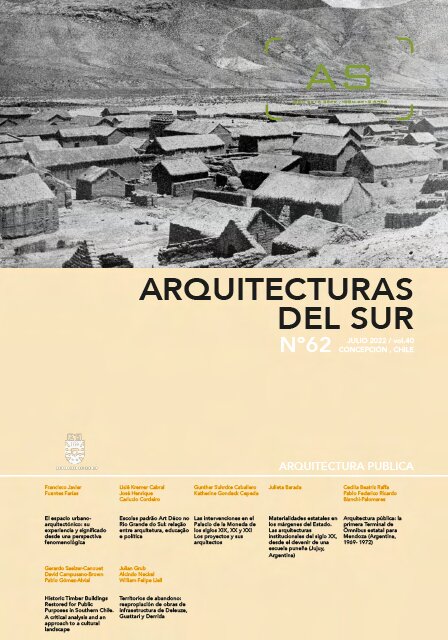The Urban and Architectural Space: Its Experience and Meaning from a Phenomenological Perspective
DOI:
https://doi.org/10.22320/07196466.2022.40.062.01Keywords:
symbolic interaction, postmodernism, subjectivity, utilitasAbstract
What is the nature of the emotional and significant life produced by architectural forms, and how can specialists in urban-architectural design understand the psycho-affective needs - emotions, sensations, meanings and memories, etc. - of future tenants of their construction project? Through a bibliographic review of a historical and theoretical-critical nature, in the present work the theoretical framework of phenomenological architecture was addressed, What is the nature of the emotional and significant life produced by architectural forms, and how can specialists in urban-architectural design understand the psycho-affective needs - emotions, sensations, meanings, memories, etc. - of future tenants of their construction project? Through a bibliographic review of a historical and theoretical-critical nature, in this work, the theoretical framework of phenomenological architecture is addressed, considering the built context and the world of people, where the meaning of the aforementioned experiences gains life. It is suggested that the sensitive or phenomenal experience of the works built by designers, allows them to access cognitive resources - empathy, inter-corporeality, social cognition - that they can use in future construction and housing projects. In recently published works, epistemic alternatives are found about the nature of the emotional and subjective life of the hypothetical inhabitant, for example, in the cases of empathy (putting oneself in another person’s shoes), the appeal or rejection of certain places, and the 'atmosphere', or the collective sensation created by social interactions in public and other spaces. The results reveal that it is the socio-urban context where architecture’s meanings are interpreted for their application in such projects. It is concluded that this perspective is a subsidiary of philosophical and semiological pragmatism, which confirms the importance of the inhabited context to understand the meaning of what others do, say, or feel. The need for an interdisciplinary and humanistic approach is also confirmed, based on methodologies of an interpretative and phenomenological nature, which give preponderance to a posteriori knowledge, which is obtained through experience.
Downloads
References
DI PAOLO, E. A., CUFFARI, E. C. y DE JAEGHER, H. (2018). Linguistic Bodies. The Continuity between Life and Languaje. Cambridge: Massachusetts Institute of Technology Press.
Frampton, K. (1999). Estudios sobre cultura tectónica. Poéticas de la construcción en la arquitectura de los siglos XIX y XX. Madrid: Akal Ediciones.
GALLAGHER, S. (2017). Enactivist Interventions. Oxford: Oxford University Press.
GALLAGHER, S. y ZAHAVI D. (2013). La mente fenomenológica. México: Alianza Editorial.
GIEDION, S. (2009). Espacio, Tiempo y Arquitectura. Barcelona: Reverté.
MALLGRAVE, H. F. (2011). The architect’s brain. Neuroscience, creativity and architecture. Chichester: Wiley-Blackwell.
MALLGRAVE, H. F. (2013). Architecture & Embodiment. The implications of the new sciences and Humanities for design. Abingdon-New York: Routledge.
MALLGRAVE, H. F. (2015). “Know thyself”: Or what designers can learn from the contemporary biological sciences. En Robinson S. y Pallasmaa, J., Mind in Architecture. Neuroscience, embodiment, and the future of design (pp. 9-31). Cambridge: Massachusetts Institute of Technology Press.
MALLGRAVE, H. F. (2018). From Object to Experience. The New Culture of Architectural Design. London: Bloomsbury Visual Arts.
MALLGRAVE, H. F. y GOODMAN, D. (2011). An Introduction to Architectural Theory. 1968 to the present. Chichester: Wiley-Blackwell.
MONTANER, J. M. (2013). Sistemas Arquitectónicos Contemporáneos. Barcelona: Gustavo Gili.
MONTANER, J. M. (2014). Del diagrama a las experiencias, hacia una arquitectura de la acción. Barcelona: Gustavo Gili.
MONTANER, J. M. (2015). La condición contemporánea de la arquitectura. Barcelona-México: Gustavo Gili.
NORBERG-SCHULZ, C. (2005). Los Principios de la arquitectura moderna. Sobre la nueva tradición del siglo XX. Barcelona: Reverte.
OTERO-PAILOS, J. (2010). Architecture’s Historical Turn. Phenomenology and the rise of the Postmodern. Minneapolis: University of Minnesota Press.
PALLASMAA, J. (2011). The Embodied Image. Imagination and Imagery in Architecture. Chichester: John Wiley & Sons.
PALLASMAA, J. (2015). Body, Mind, and Imagination. The Mental Essence of Architecture. En Robinson, S. y Pallasmaa, J. (Eds.). Mind in Architecture. Neuroscience, Embodiment and the Future of Design (pp. 51-74). Cambridge: Massachusetts Institute of Technology Press.
PALLASMAA, J. (2016). Habitar. Barcelona: Gustavo Gili.
PÉREZ-GÓMEZ, A. (2015). Mood and meaning in architecture. En Robinson, S. y Pallasmaa, J., Mind in Architecture. Neuroscience, Embodiment, and the Future of Design (pp. 219-235). Cambridge: Massachusetts Institute of Technology Press.
PÉREZ-GÓMEZ, A. (2016). Attunement. Architectural Meaning after the crisis of Modern Science. Cambridge: Massachusetts Institute of Technology Press.
RASMUSSEN, S. E. (2014). La experiencia de la Arquitectura. Sobre la percepción de nuestro entorno. Barcelona: Ed. Reverté.
ROBINSON, S. y PALLASMAA, J. (Eds.) (2015). Mind in Architecture. Neuroscience, Embodiment, and the Future of Design. Cambridge: Massachusetts Institute of Technology Press.
SHARR, A. (2018). La cabaña de Heidegger. Barcelona: Gustavo Gili.
STEWART, J., GAPENNE, O. y DI PAOLO, E. (Eds.) (2014). Enaction. Toward a New Paradigm for Cognitive Science. Cambridge: Massachusetts Institute of Technology Press.
ZUMTHOR, P. (2017). Pensar la Arquitectura. Barcelona: Gustavo Gili.
Downloads
Published
How to Cite
Issue
Section
License
Copyright (c) 2022 Francisco Javier Fuentes-Farías

This work is licensed under a Creative Commons Attribution-ShareAlike 4.0 International License.
The content of the articles published in each issue of Arquitecturas del Sur is the sole responsibility of the authors and does not necessarily represent the opinion of University of the Bío-Bío.
The authors will maintain their copyright; however, they will guarantee the journal the right to first publication and dissemination of their work. The publication of the article in Arquitecturas del Sur will be subject to the Creative Commons International license (CC BY-SA) that allows others to adapt: remix, transform and build on the material for any purpose, even commercially; share: copy and redistribute the material in any medium or format, as long as the authorship and first publication in this journal are acknowledged by citing them correctly, and their new contributions are under a license with the same terms.














 Programa de Información Científica/Concurso Fondos de Publicación de Revistas Científicas 2018/ Proyecto Mejoramiento de Visibilidad de Revistas UBB (Código:FP180007)
Programa de Información Científica/Concurso Fondos de Publicación de Revistas Científicas 2018/ Proyecto Mejoramiento de Visibilidad de Revistas UBB (Código:FP180007) 
